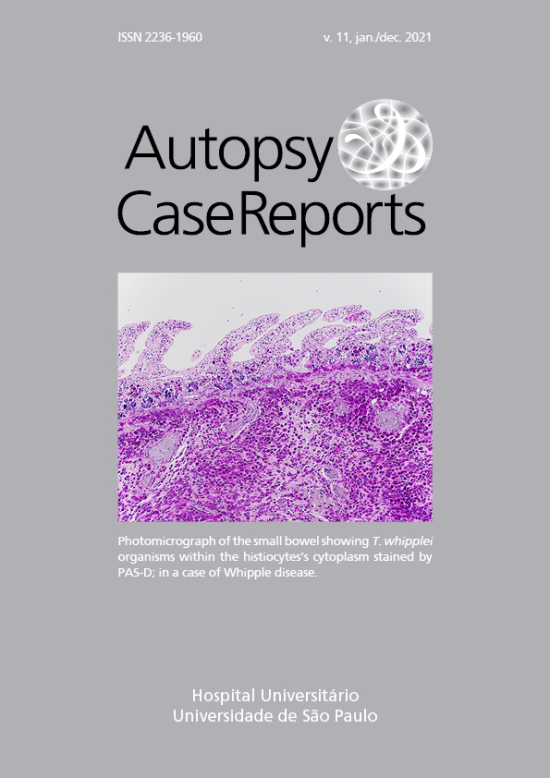A pancreatic mixed neuroendocrine-non-neuroendocrine neoplasms (MiNEN) (NET and undifferentiated carcinoma of the pancreas with osteoclast-like giant cells) with metastatic neuroendocrine component to the liver
DOI:
https://doi.org/10.4322/acr.2020.201Keywords:
Pancreatic Neoplasms, Ductal Carcinoma of the Pancreas, Neuroendocrine Tumors, CarcinomasAbstract
Undifferentiated carcinoma of the pancreas with osteoclast-like giant cells (UCOGCs) is an extremely rare morphologically and clinically distinct variant of pancreatic ductal adenocarcinoma (PDAC), exhibiting a characteristic component of reactive osteoclast-like giant cells admixed with neoplastic mononuclear cells. Sommers and Meissner first described it in 1954 as an “unusual carcinoma of the pancreas”. Later it acquired many different names. In 2010, the WHO classified these tumors as a variant of PDAC under the heading of “undifferentiated carcinoma with osteoclast-like giant cells”. Here we describe the first case of pancreatic mixed neuroendocrine-non-neuroendocrine neoplasms (MiNEN) composed of UCOGC and pancreatic neuroendocrine tumor (NET), which occurred in a 78-year-old man with biliary colic and pancreatitis. The mass did not respond to the chemotherapy, and he soon developed liver metastasis from the NET component, and unfortunately, the patient passed away 10 months later. Since UCOGC is extremely rare, and its association with NET has not been reported yet, our case expands the knowledge regarding its unusual presentation and poor prognosis.
Downloads
References
Rahib L, Smith BD, Aizenberg R, Rosenzweig AB, Fleshman JM, Matrisian LM. Projecting cancer incidence and deaths to 2030: the unexpected burden of thyroid, liver, and pancreas cancers in the United States. Cancer Res. 2014;74(11):2913-21. http://dx.doi.org/10.1158/0008-5472.CAN-14-0155. PMid:24840647.
Noone AM, Howlader N, Krapcho M, et al, editors. SEER cancer statistics review, 1975-2015 [Internet]. Bethesda: National Cancer Institute; 2015 [cited 2018 Apr 1]. Available from: https://seer.cancer.gov/csr/1975_2015/
Kamisawa T, Wood LD, Itoi T, Takaori K. Pancreatic cancer. Lancet. 2016;388(10039):73-85. http://dx.doi.org/10.1016/S0140-6736(16)00141-0. PMid:26830752.
Temesgen WM, Wachtel M, Dissanaike S. Osteoclastic giant cell tumor of the pancreas. Int J Surg Case Rep. 2014;5(4):175-9. http://dx.doi.org/10.1016/j.ijscr.2014.01.002. PMid:24631915.
Sommers SC, Meissner WA. Unusual carcinomas of the pancreas. AMA Arch Pathol. 1954;58(2):101-11. PMid:13170907.
Klimstra DS, Kloppel G, La Rosa S, Rindi G. Classification of neuroendocrine neoplasms of the digestive system. In: WHO Classification of Tumours Editorial Board, editor. WHO classification of tumours: digestive system tumours. 5th ed. Lyon: IARC Press; 2019.
Luchini C, Pea A, Lionheart G, et al. Pancreatic undifferentiated carcinoma with osteoclast-like giant cells is genetically similar to, but clinically distinct from, conventional ductal adenocarcinoma. J Pathol. 2017;243(2):148-54. http://dx.doi.org/10.1002/path.4941. PMid:28722124.
Luchini C, Cros J, Pea A, et al. PD-1, PD-L1, and CD163 in pancreatic undifferentiated carcinoma with osteoclast-like giant cells: expression patterns and clinical implications. Hum Pathol. 2018;81:157-65. http://dx.doi.org/10.1016/j.humpath.2018.07.006. PMid:30031096.
Athanasios P, Alexandros P, Nicholas B, et al. Pleomorphic giant cell carcinoma of the pancreas with hepatic metastases: initially presenting as a benign serous cystadenoma: a case report and review of the literature. HPB Surg. 2010;2010:627360. http://dx.doi.org/10.1155/2010/627360. PMid:21197435.
Menteş A, Yüce G. Osteoclast-type giant cell tumor of the pancreas associated with mucinous cystadenoma. Eur J Surg Oncol. 1993;19(1):84-6. PMid:8436245.
Rustagi T, Rampurwala M, Rai M, Golioto M. Recurrent acute pancreatitis and persistent hyperamylasemia as a presentation of pancreatic osteoclastic giant cell tumor: an unusual presentation of a rare tumor. Pancreatology. 2011;11(1):12-5. http://dx.doi.org/10.1159/000323210. PMid:21311208.
Lukás Z, Dvorák K, Kroupová I, Valásková I, Habanec B. Immunohistochemical and genetic analysis of osteoclastic giant cell tumor of the pancreas. Pancreas. 2006;32(3):325-9. http://dx.doi.org/10.1097/01.mpa.0000202951.10612.fa. PMid:16628090.
Mullick SS, Mody DR. “Osteoclastic” giant cell carcinoma of the pancreas: report of a case with aspiration cytology. Acta Cytol. 1996;40(5):975-9. http://dx.doi.org/10.1159/000334012. PMid:8842177.
Shi C, Klimstra DS. Pancreatic neuroendocrine tumors: pathologic and molecular characteristics. Semin Diagn Pathol. 2014;31(6):498-511. http://dx.doi.org/10.1053/j.semdp.2014.08.008. PMid:25441311.
Tang LH, Basturk O, Sue JJ, Klimstra DS. A practical approach to the classification of WHO Grade 3 (G3) Well-differentiated Neuroendocrine Tumor (WD-NET) and Poorly Differentiated Neuroendocrine Carcinoma (PD-NEC) of the Pancreas. Am J Surg Pathol. 2016;40(9):1192-202. http://dx.doi.org/10.1097/PAS.0000000000000662. PMid:27259015.
Waddell N, Pajic M, Patch AM, et al. Whole genomes redefine the mutational landscape of pancreatic cancer. Nature. 2015;518(7540):495-501. http://dx.doi.org/10.1038/nature14169. PMid:25719666.
Hijioka S, Hosoda W, Mizuno N, et al. Does the WHO 2010 classification of pancreatic neuroendocrine neoplasms accurately characterize pancreatic neuroendocrine carcinomas? J Gastroenterol. 2015;50(5):564-72. http://dx.doi.org/10.1007/s00535-014-0987-2. PMid:25142799.
Kimura T, Miyamoto H, Fukuya A, et al. Neuroendocrine carcinoma of the pancreas with similar genetic alterations to invasive ductal adenocarcinoma. Clin J Gastroenterol. 2016;9(4):261-5. http://dx.doi.org/10.1007/s12328-016-0655-6. PMid:27262570.
Muraki T, Reid MD, Basturk O, et al. undifferentiated carcinoma with osteoclastic giant cells of the pancreas: clinicopathologic analysis of 38 cases highlights a more protracted clinical course than currently appreciated. Am J Surg Pathol. 2016;40(9):1203-16. http://dx.doi.org/10.1097/PAS.0000000000000689. PMid:27508975.
Basturk O, Tang L, Hruban RH, et al. Poorly differentiated neuroendocrine carcinomas of the pancreas: a clinicopathologic analysis of 44 cases. Am J Surg Pathol. 2014;38(4):437-47. http://dx.doi.org/10.1097/PAS.0000000000000169. PMid:24503751.
Serafini S, Da Dalt G, Pozza G, et al. Collision of ductal adenocarcinoma and neuroendocrine tumor of the pancreas: a case report and review of the literature. World J Surg Oncol. 2017;15(1):93. http://dx.doi.org/10.1186/s12957-017-1157-9. PMid:28464920.
Wang Y, Gandhi S, Basu A, et al. Pancreatic collision tumor of ductal adenocarcinoma and neuroendocrine tumor. ACG Case Rep J. 2018;5(1):e39. http://dx.doi.org/10.14309/crj.2018.39. PMid:29850646.
Downloads
Published
Issue
Section
License
Copyright (c) 2021 Autopsy and Case Reports

This work is licensed under a Creative Commons Attribution 4.0 International License.
Copyright
Authors of articles published by Autopsy and Case Report retain the copyright of their work without restrictions, licensing it under the Creative Commons Attribution License - CC-BY, which allows articles to be re-used and re-distributed without restriction, as long as the original work is correctly cited.



